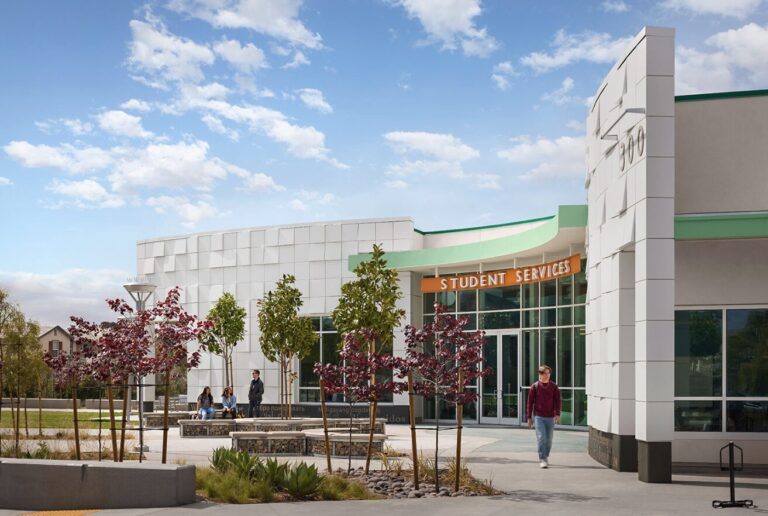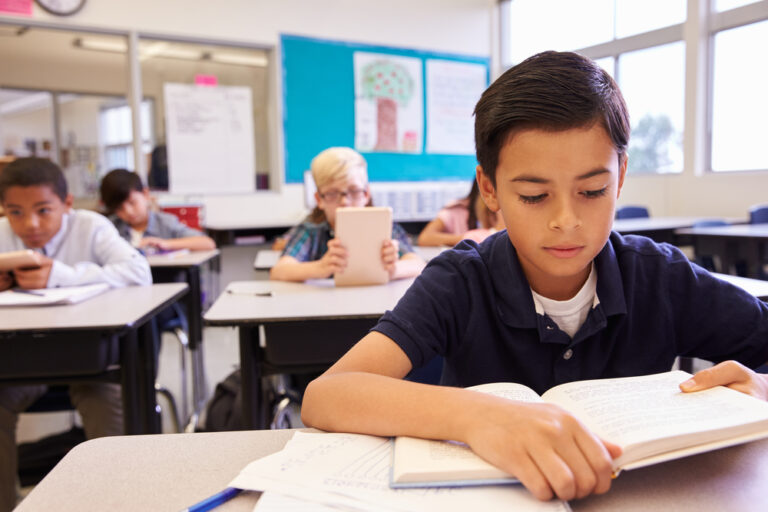By Melanie Slone
“My parents are immigrants from Mexico. I found myself translating for my parents, learning English, and really navigating the school system by myself,” Rosana Martinez, the lead community school coordinator for Oceanside Unified School District, tells North County Informador. “I had to do this alone.”
Today, things have changed. Many districts in California are linking schools and the community through an initiative called community schools. “Community schools partner with community agencies and local government to align community resources to improve student outcomes,” according to the California Department of Education.
We talked with leaders in the community school program at four North County school districts to find out what they are doing for students and families and how everyone can get involved.
Escondido Union School District

“A community school is a place all families feel they can come on campus, receive services…their one-stop location for anything they might need,” explains Kimberly Israel, the coordinator of community outreach for the Escondido School District (elementary level).
There is a family liaison at each of the 26 schools. “Our family liaisons are in place to build community,” Kimberly says. “Most of our schools have family engagement centers that are resource centers right there, that have clothing and basic needs supplies.”
Escondido has won awards at the state level for the work and just won a grant to enhance services at 16 of the most in-need schools.
Since becoming the first school social worker in 2000, Kimberly has seen the changes. “None of this existed. It was very clear that schools and social service agencies were two different entities.”
She now oversees “the student and family services team of social workers and counselors…a team of bilingual, bicultural family liaisons.”
When Kimberly began as a teacher in the Chicago public schools, her campus had a school-based health system, so she decided to get a master’s in public health and a master’s in social work, eventually taking her experience to Escondido.
“I conducted a two-year needs assessment process, and what came from the community was the need to have access to services through schools.” She began writing grants and getting the funds needed to launch and grow these programs. The growth has been phenomenal. “We have over 2,400 events this year, over 6,600 parents signed in at any given time.”
But the true success is reflected in the families. The staff “come into every meeting with a new story of a family in need that came to them; they were able to come up with solutions, support that family, and that’s the true impact.”
All families can become part of the decision-making team at their children’s schools. “It can be very intimidating to talk to a teacher,” says Kimberly. But parents need to be involved. “It doesn’t mean you have to be present at everything. It means you are aware of what your kids are learning in the classroom, and you are communicating with the teacher about what you can do to support that learning…Ask questions as parents.”
Income and immigration status are not a barrier. “Schools welcome all families in our district,” she says.
“We have families that spend so much time at our schools. There’s something for them to do in those family resource center classrooms or at an event. It really feels like a place where the community belongs.”
Escondido Family Liaisons
- Do outreach through calls, texts, emails, and at enrollment and orientation days
- Welcome families and help them enroll their students
- Help parents understand the school system and participate in events
- Provide training through Latino Literacy program to encourage families to read bilingual books that celebrate culture
- Support outreach and education classes
- Link families with transportation, housing, food, mental health, and basic needs
Vista Unified School District

Through the Family and Community Engagement (FACE) Network for Vista Unified School District, Kiki Bispo leads the team of community liaisons assigned to school sites.
Historically, she tells us, “children have lived in three different worlds: home, school, and community.” FACE is that “bridge to ensure that our three worlds are working together in supporting children and students.”
The community liaisons “make sure parents can effectively engage and be a true part of their child’s education, knocking down the barriers and obstacles that might prevent that,” says Kiki.
The program, similar to the one in Escondido, connects families with resources or with a community partner.
Kiki has worked in education for 20 years, first as a as high school science teacher, leadership counselor, and girls’ basketball coach in central LA. Eventually, she realized she wanted to impact not only lives but the entire school system.
In San Diego she found a way—as lead of FACE Network. “I was already a social justice activist and advocate, doing my work through education; I saw the opportunity to keep working at a ground or foundational level.”
The FACE program became a model system across the state and then the country, uniting schools and families for the good of the students. “Parents are children’s first teachers. We have to work together, and we have to honor home first,” says Kiki. She encourages parents to learn the education system at all levels so they can support their kids.
FACE launched 10 years ago with 10 liaisons. Today, it boasts 29 community liaisons, an early childhood education fair to promote preschool, and links with community service programs.
Kiki has built lasting relationships, including with an immigrant family from Mexico with a son and two younger daughters, whom she saw at every workshop and event over the years. “The middle girl is now a student at UC Santa Barbara, and her brother is on his second engineering degree at Stanford,” she tells us.
Kiki is still close to this family. “These kids are growing, and I feel like I’m part of their family…when you show you genuinely care, that you listen to needs, that you get to know people and honor their cultures and the skills they have, what they want for their children, you can effectively work together.”
Vista Community Liaisons
- Ensure parents understand the school system in English and Spanish
- Make sure families can communicate effectively with the school and teachers, principal, counselor
- Empower parents to act in committees
- Connect families with resources and partners
- Provide workshops or presentations for parents
- Walk parents through the school platform
- Send mass emails, texts before events
- Help families in the parking lot at pick up and drop off
Oceanside Unified School District

“In the spring of 2021, our Board of Education identified community schools as a priority in response to the hardships heightened by the Covid-19 pandemic and systemic inequity opportunities,” says Rosana Martinez. “OUSD examined the needs of each district and school to identify where to pilot the community schools.” That is how the Community School Initiative was born.
Each of the six schools currently under the program offers a unique program, says Rosana. “Our vision is to transform our schools into student- and family-centered hubs, and our mission is to improve student outcomes,” she adds.
The six community schools offer health services, basic needs such as food distribution, and partners with enrichment activities for students.
Rosana knew since she was a little girl that she wanted to work in education. She has come full circle as an alumna of Mission Elementary, Jefferson Middle School, and Oceanside High. But her parents never had a voice. “This is why I’m so passionate about what I do, because I came from this community.”
There were no community programs back then. “Now, having these needs being met by our community school coordinators at each of these six school sites has been life changing” she says.
“My parents stayed away from the school. There was like a division. But now, we are saying, families, please engage with us…We are a community. We want to hear what you’re going through.”
Language is not a barrier, she says. At the district level, Diane Kemp López and her team provide free translation and interpretation support for families.
“Whatever is going on at home shouldn’t be a barrier,” says Rosana. “We’re all here to support your child.”
Rosana wants to let families know they are not alone. “We’re here. Community school coordinators are available at the school sites; they have a trusted individual that they can go to.”
San Marcos Unified School District

Born in Oaxaca, Mexico, Anileydi “Ani” Diaz-Chavez came to San Marcos as a young child, so she was a student in the district from kindergarten through 12th grade. She then graduated from Cal State San Marcos. “So, San Marcos all the way,” she tells us.
Today, as the San Marcos Unified School District parent liaison, Ani brings workshops and resources to families and supports afterschool programs for TK through 8th grade, including hands-on practice on school platforms so parents can access grades and check assignments in their chosen language.
“I enjoy helping parents and being that extra hand to them…knowing that we can take care of them, make them feel that they’re not alone,” says Ani.
San Marcos Elementary is the district community school, where holistic health services are offered, including a spring health fair with enrollment assistance. Students can get their physicals and dental screenings as they enroll in school. Also, over 200 families benefit from food pantries through Feeding San Diego at Julian and San Marcos Elementary.
Ani has held this position since February 2023, after working to connect families with resources through the Boys & Girls Club of San Marcos.
Her experience now benefits San Marcos Unified. “I love not only bringing resources to families but also empowering them and teaching them how to do things by themselves,” she says
The district also has six schools with bilingual community liaisons. Because parent engagement and involvement are so critical to student success, Ani encourages families to reach out in any way they can. “Even if it’s something small, it goes a long way, and building that connection with the schools and the students is very important.”
In Spanish, says Ani, “saber es poder—knowledge is power—and I want parents not to be afraid of not knowing…I want them to feel welcome to reach out, and we’ll find a way.”




